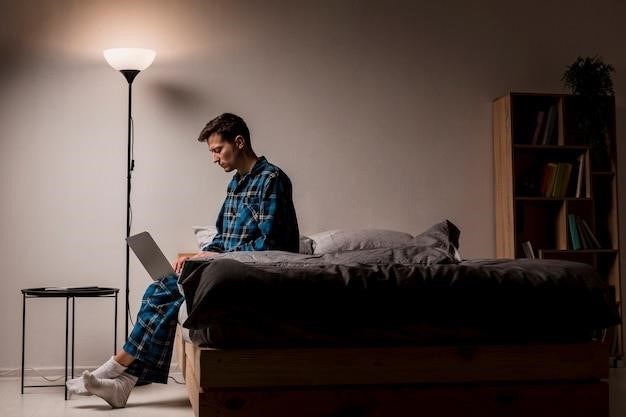A Dark Room Guide⁚ Setting Up Your Space
Creating a functional darkroom, even in a small space, is achievable․ Consider factors like light-tightness, ventilation, and convenient workspace arrangement․ Essential equipment includes a light-safe environment, enlarger, trays, and chemical storage․ Proper setup ensures successful film processing and printing․
Choosing the Right Room
Selecting the ideal location for your darkroom involves careful consideration of several key factors․ Firstly, light-tightness is paramount․ A room with minimal or no windows is preferable, as even small gaps can compromise the development process․ If windows are unavoidable, ensure they are thoroughly sealed with blackout curtains or other light-blocking materials․ Size is another important factor; while a large space is advantageous, a small room can still accommodate a functional darkroom setup with efficient space planning․ Consider proximity to a water source for easy chemical disposal․ Adequate ventilation is essential to mitigate the fumes generated by photographic chemicals․ A well-ventilated space helps maintain a healthy and safe working environment․ Finally, consider the room’s accessibility and its proximity to your other photographic equipment for ease of workflow․
Lightproofing Your Darkroom
Achieving complete darkness within your darkroom is crucial for successful film development and printing․ Thoroughly examine the room for any potential light leaks․ Common culprits include gaps around windows, doors, and electrical outlets․ Seal these openings using caulk, weather stripping, or black electrical tape․ Windows require special attention․ Heavy, opaque curtains or blinds are essential; consider layering multiple layers for added protection․ For particularly stubborn light leaks, consider using light-blocking paint or specialized darkroom sealing materials․ Test your lightproofing efforts by spending time in complete darkness, allowing your eyes to adjust․ Even a small amount of light can ruin exposed photographic materials․ Don’t neglect checking for light leaks around the door frame, which often gets overlooked․ A thorough approach to lightproofing ensures a safe and effective darkroom environment, protecting your film and prints from unwanted exposure․
Essential Darkroom Equipment
Building a functional darkroom requires specific equipment․ An enlarger is fundamental for enlarging negatives onto photographic paper․ Choose an enlarger compatible with your negative format (e․g․, 35mm, 120)․ Essential also are developing trays, typically three⁚ one for developer, one for stop bath, and one for fixer․ These should be made of chemically resistant materials such as stainless steel or plastic․ Accurate timing is crucial; a darkroom timer is essential for precise chemical processing․ A safelight is needed – a low-intensity red light that allows you to work in the darkroom without exposing your materials․ Consider a thermometer to monitor chemical temperatures, crucial for consistent results․ Tongs and other handling tools prevent fingerprints and scratches on your negatives and prints․ Finally, adequate storage for chemicals, negatives, and prints is vital․ Proper storage protects your supplies from light and maintains their usability․ Investing in high-quality, durable equipment safeguards your darkroom workflow and produces superior results․ Remember to always consult safety guidelines when handling photographic chemicals․

Developing Film⁚ A Step-by-Step Guide
Developing film involves precise steps⁚ preparing chemicals, loading film into a tank, developing, stopping, fixing, washing, and drying․ Each step requires careful timing and attention to detail for optimal results․ Consult detailed instructions specific to your film and chemicals․
Preparing Your Chemicals and Supplies
Before embarking on the film developing process, meticulous preparation is paramount․ Gather all necessary materials⁚ developer, stop bath, fixer, wetting agent, and appropriate measuring tools․ Ensure your darkroom is completely light-tight to prevent unwanted exposure․ Prepare your chemicals according to the manufacturer’s instructions, paying close attention to mixing ratios and temperatures․ Use clean, graduated cylinders or similar tools for accurate measurements to avoid inconsistencies in your results․ Have several trays or containers ready for each chemical stage to maintain cleanliness and prevent cross-contamination․ Remember to label each container clearly, and always wear appropriate safety gear, including gloves and eye protection, to handle chemicals safely․ Adequate ventilation is essential when working with photographic chemicals․ Prepare your developing tank and reels; ensure they are clean and ready to receive the film․ Also, collect clean water, film clips, and a timer for precise timing of each development step․ Finally, gather lint-free towels for drying the film and any necessary cleaning supplies․ Thorough preparation significantly impacts the quality and success of your film development․
The Film Developing Process
Once your chemicals and equipment are prepared, load your film into the developing tank in complete darkness․ Begin by pre-soaking the film in water to ensure even development․ Then, carefully pour the developer into the tank, ensuring it covers the film completely․ Agitate gently but consistently for the specified time to ensure uniform chemical action across the film’s surface․ Next, transfer the film to the stop bath to halt the developing process․ This step is crucial to prevent overdevelopment and uneven tones․ Again, agitate gently according to the recommended time․ Following the stop bath, immerse the film in the fixer, which hardens the emulsion and makes the image lightfast․ Agitate carefully during this stage as well․ Finally, wash the film thoroughly with clean water to remove any residual chemicals․ A wetting agent may be added to the final rinse to help prevent water spots․ After washing, carefully remove the film from the tank under safelight conditions․ Hang the film to dry, ensuring no dust particles settle on the wet emulsion․ Remember that precise timing and careful handling are essential for successful film development․ Consult the manufacturer’s instructions for your specific film and chemicals for accurate timings and procedures․
Troubleshooting Common Issues
Film developing and printing often present challenges․ Uneven development might stem from insufficient agitation or temperature variations during processing․ Check your chemical temperatures and ensure thorough, consistent agitation throughout each stage․ If your negatives are too light, the exposure may have been inadequate․ Recheck your camera settings and ensure proper exposure times․ Conversely, overly dark negatives suggest overexposure․ Adjust your camera settings accordingly․ Streaks or spots on your prints often point to dust or debris on the negatives or in the darkroom․ Always handle negatives carefully and keep your darkroom meticulously clean․ Fogging, where the entire negative appears light gray, indicates light leaks in the darkroom or improper safelight usage․ Ensure your darkroom is entirely light-tight and that your safelight is appropriate for your film type․ For issues with contrast, ensure your chemicals are fresh and stored properly․ Expired or improperly stored chemicals will lead to poor results․ Always refer to manufacturer’s instructions for proper handling and storage of your film and chemicals․ By systematically addressing these potential problems, you can significantly improve the quality of your darkroom work․ Remember meticulous attention to detail is key to success․

Darkroom Printing Techniques
Mastering darkroom printing involves precise enlarger setup, careful negative handling, and skillful chemical processing to achieve desired tones and contrasts․ Developing and printing photographic paper requires precise timing and chemical control․ Advanced techniques, such as dodging and burning, add creative control to enhance your prints․
Enlargers and Negative Handling
The enlarger is the cornerstone of darkroom printing, projecting a magnified image of your negative onto photosensitive paper․ Choosing the right enlarger depends on your needs; consider factors like lens quality, negative size compatibility, and ease of use․ Proper maintenance is crucial; keep the lens clean and the light source properly aligned to avoid blurry prints․ Before placing your negative in the enlarger’s negative carrier, ensure it’s free from dust and fingerprints․ Use a dust brush or blower to gently remove any particles․ Handle negatives carefully to avoid scratching; use archival-quality gloves to prevent fingerprints and oils from transferring․ The negative carrier itself should be clean and in good working order; replace it if it’s damaged or scratched, as this will impact the quality of your prints; Accurate alignment of the negative within the carrier is essential for sharp, well-centered images․ Use a loupe or magnifier to precisely adjust the negative’s position before you begin the enlargement process․ Pay attention to the focus of the enlarger; a perfectly focused image is vital to achieving sharp details in your prints․ Experiment with different levels of magnification to discover the ideal size for your prints and for your preferred aesthetic result․ Remember that even minor imperfections in the negative handling process can lead to significant flaws in your final prints․
Developing and Printing Photographs
Once your enlarger is set up and your negative is precisely positioned, you’re ready to begin the printing process․ Start by selecting your photographic paper; consider the paper’s contrast grade and surface texture to match your negative and desired aesthetic․ After placing the paper on the baseboard, expose it to light from the enlarger for a specific duration, carefully timed using a timer․ This exposure creates a latent image on the paper․ Next, carefully place the exposed paper into the developer tray, ensuring complete immersion in the chemical solution․ The developer gradually brings the latent image to visibility, revealing the tones and details of your photograph․ The developing time depends on the specific chemicals and the desired contrast․ Always follow the manufacturer’s instructions precisely․ After development, immediately transfer the print to the stop bath․ This neutralizes the developer, halting the development process and preventing further changes in the image’s tones․ After the stop bath, immerse your print in the fixer․ The fixer removes the unexposed silver halide crystals from the paper, making the image permanent and lightfast․ The fixing process takes longer than development․ Finally, wash the print thoroughly under running water to remove any residual chemicals․ This is crucial for the print’s longevity and prevents discoloration over time․ After washing, allow the print to dry completely before handling it to avoid smudging or damaging the delicate emulsion․
Advanced Techniques⁚ Dodging and Burning
Dodging and burning are essential darkroom techniques for controlling contrast and enhancing specific areas within your photograph․ Dodging involves selectively reducing exposure to certain parts of the print during the enlarging process, lightening those areas․ This is achieved by using a variety of tools, such as hands, cardboard cutouts, or specialized dodging tools, to temporarily block light from reaching specific sections of the photographic paper․ Burning, conversely, increases exposure to selected areas, darkening them․ This is done by briefly exposing those areas to light for a longer duration than the rest of the print․ Both dodging and burning are achieved during the exposure phase; precise movements and timing are key to achieving subtle and effective results․ Practice is essential to master these techniques, as control over the amount of light blocked or added is critical․ Experimentation with different tools and techniques will allow you to develop your personal style and achieve unique effects․ For example, a gradual, soft dodge can subtly lighten a harsh highlight, while a sharp, precise burn can accentuate a detail or create a dramatic shadow․ Mastering dodging and burning elevates your darkroom skills, allowing you to fine-tune your prints and express your artistic vision with greater precision․ The results are photographs with enhanced depth, improved tonal balance, and a more refined aesthetic appeal, showcasing your unique artistic vision․
